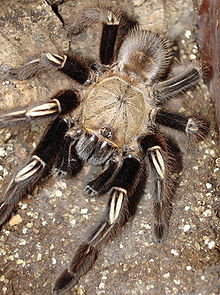- Skeleton tarantula
-
Ephebopus murinus 
Scientific classification Kingdom: Animalia Phylum: Arthropoda Class: Arachnida Order: Araneae Family: Theraphosidae Subfamily: Aviculariinae Genus: Ephebopus Species: E. murinus Binomial name Ephebopus murinus
(Walckenaer, 1837)Synonyms Mygale murina Walckenaer, 1837
Santaremia pococki P.-Cambridge, 1896The skeleton tarantula, Ephebopus murinus, is a species of spider belonging to the family Theraphosidae (tarantulas), sub-family Aviculariinae. A New World species, it is native to several South American countries. Its common name is derived from the skeleton-like markings on its legs.
Contents
Taxonomy
The species was first described by Charles Athanase Walckenaer in 1837 as Mygale murina.[1][2] In 1892, Eugène Simon placed it in his genus Ephebopus.[3] Frederick Octavius Pickard-Cambridge described it as Santaremia pococki in 1896 (creating a new genus).[4] Later Reginald Innes Pocock (1903) synonymised S. pococki with E. murinus,[5] which remains the species' accepted scientific name to date.
The generic name, Ephebopus is derived from the Greek meaning youth(ful) plus foot, and the specific name, murinus is from the Latin meaning mouse colored.[6]
Description
The adult E. murinus usually grows to a leg span of about 11–12 cm (4.5 inches), though females can grow as large as 15 cm (6 inches).[7]
The legs are black, the abdomen is small and brown, and the carapace is coffee colored or golden. The leg striping is similar to that of Aphonopelma seemani, but more yellowish in colour.[7]
Habitat and distribution
E. murinus is a terrestrial, semi-fossorial, lowland forest-dwelling species native to northern Brazil, French Guiana, and Suriname.[1]
Behavior
Unlike most members of the subfamily Aviculariinae, which are arboreal, E. murinus lives mainly on or near the forest floor, where it will build a heavily-webbed burrow beneath the topsoil or amongst branches, rocks, and other forest floor debris.
As a defense against potential predators, and in common with many other New World tarantulas, the species of the Ephebopus genus will brush urticating hairs from their bodies. But uniquely, rather than being located on the abdomen, Ephebopus urticating hairs are located on the spider's palps - on the medial side of the palpal femora.[8]
E. murinus is also a fast and aggressive species, and will readily rise up and present its fangs to a potential predator.[9]
Diet
In common with most terrestrial tarantula species, Ephobopus murinus feeds on ground-dwelling insects, worms and small mammals.
In captivity
E. murinus should be kept solitary, in a tank of around 20 litres (about 5 gallons), with floor space being more important than height. A substrate depth of about 10–15 cm (4–6 in) and a good retreat are needed for it to establish a burrow, which it will line heavily with web. The species needs a temperature of 22-26°C (71.6-78.8°F), and a humidity of about 80% (usually maintained using a water dish).[10]
Keepers should exercise caution due to this species' speed and aggressive nature.[9]
See also
References
- ^ a b Platnick, N. I. (2009). "The World Spider Catalog, version 10.5, Theraphosidae". American Museum of Natural History. http://research.amnh.org/iz/spiders/catalog/THERAPHOSIDAE.html. Retrieved 2010-02-28.
- ^ Walckenaer, C. A. (1837). Histoire naturelle des insectes. 1. Paris: Aptères. pp. 1–682.
- ^ Simon, E. (1892). Histoire naturelle des araignées. 1. Paris. pp. 1–256.
- ^ Pickard-Cambridge, F. O. (1896). "On the Theraphosidae of the lower Amazons: being an account of the new genera and species of this group of spiders discovered during the expedition of the steamship "Faraday" up the river Amazons". Proc. zool. Soc (London) 1896: 81–115.
- ^ Pocock, R. I. (1903). "On some genera and species of South American Aviculariidae". Ann. Mag. nat. Hist.. 7 11: 81–115.
- ^ Beechhold, H. F. (2009). "A Key to the Pronunciation and Meaning of Scientific Names of Popular Species". American Tarantula Society, Forum, vol=6, issues 4,5. http://atshq.org/articles/beechwp2.html. Retrieved 2010-02-28.
- ^ a b "Skeleton Tarantula Ephebopus murinus". http://www.eightlegs.org/skel/skeleton.html. Retrieved 2010-10-23.
- ^ Foelix, R., Rast, B., Erb, B. (2009). "Palpal urticating hairs in the tarantula Ephebopus: fine structure and mechanism of release". The Journal of Arachnology 37: 292–298.
- ^ a b Samuel D. Marshall (2001), Tarantulas and other arachnids, p. 71, ISBN 9780764114632, "Skeleton tarantulas are so-called due to lengthwise striping on the legs, ... They are very aggressive ..."
- ^ "Ephebopus murinus". Wikipets. http://www.care-sheet.com/index/Ephebopus_murinus. Retrieved 2010-02-28.
External links
- Tarantula Bibliography, Ephebopus - A bibliographical directory for the genus Ephebopus
Categories:- Theraphosidae
- Spiders of South America
- Fauna of Brazil
- Fauna of Suriname
- Fauna of French Guiana
- Animals described in 1837
Wikimedia Foundation. 2010.
